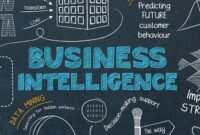Business intelligence analysis is the key to unlocking data-driven insights that empower businesses to make informed decisions and achieve remarkable outcomes. By harnessing the power of data, organizations can gain a competitive edge, optimize operations, and drive growth.
This comprehensive guide delves into the intricacies of business intelligence analysis, exploring its core components, techniques, tools, and applications. Discover how data-driven decision-making can transform your business and propel it towards success.
Definition and Overview of Business Intelligence Analysis
Business intelligence analysis is the process of collecting, analyzing, and interpreting data to gain insights that inform business decisions. It helps businesses understand their current performance, identify trends, and make predictions about the future.
For instance, a retail store might use business intelligence analysis to track sales data, identify best-selling products, and optimize pricing strategies.

The benefits of business intelligence analysis include improved decision-making, increased efficiency, and reduced costs. However, implementing business intelligence analysis can also be challenging, as it requires access to data, skilled analysts, and the right technology.
Key Components of Business Intelligence Analysis
Data Collection, Business intelligence analysis
The first step in business intelligence analysis is to collect data from various sources, such as internal databases, external data feeds, and customer surveys. Data can be structured (e.g., sales records) or unstructured (e.g., customer feedback).
Data Analysis
Once data is collected, it needs to be analyzed to identify patterns, trends, and anomalies. This can be done using a variety of statistical and data mining techniques.
Data Visualization
The results of data analysis are often presented in visual formats, such as charts, graphs, and dashboards. This makes it easier for decision-makers to understand the insights and take action.
Data Quality and Data Management
The quality of data is crucial for business intelligence analysis. Data must be accurate, complete, and consistent. Data management practices ensure that data is properly organized and accessible.
Data Governance and Data Security
Data governance ensures that data is used ethically and responsibly. Data security measures protect data from unauthorized access and breaches.
Business intelligence analysis provides crucial insights for businesses to make informed decisions. Skilled professionals in this field are in high demand, with many pursuing business intelligence engineer jobs.
These professionals design, implement, and maintain data analytics solutions, empowering businesses with data-driven insights to optimize operations and drive growth.
Ultimately, business intelligence analysis remains a critical tool for businesses seeking competitive advantage in today’s data-driven market.
Techniques and Methodologies for Business Intelligence Analysis
Data Mining
Data mining is a process of extracting hidden patterns and insights from large datasets. It can be used to identify customer segments, predict customer behavior, and detect fraud.
Statistical Analysis
Statistical analysis involves using statistical techniques to analyze data and draw conclusions. It can be used to test hypotheses, identify relationships between variables, and make predictions.
Predictive Analytics
Predictive analytics uses historical data to predict future events. It can be used to forecast demand, identify risks, and optimize marketing campaigns.
Business intelligence analysis is crucial for businesses seeking data-driven insights to improve decision-making.
The magic quadrant for analytics and business intelligence platforms provides a comprehensive evaluation of leading solutions, enabling organizations to select the best fit for their specific needs.
By leveraging business intelligence analysis, businesses can transform raw data into actionable information, empowering them to make informed decisions and achieve competitive advantages.
Tools and Technologies for Business Intelligence Analysis
| Tool | Features | Capabilities | Pricing |
|---|---|---|---|
| Tableau | Data visualization, data analysis, collaboration | Interactive dashboards, data blending, predictive analytics | Free trial, paid plans starting at $15 per month |
| Power BI | Data visualization, data analysis, reporting | Customizable dashboards, AI-powered insights, integration with Microsoft products | Free trial, paid plans starting at $9.99 per month |
| QlikView | Data visualization, data analysis, in-memory analytics | Associative engine, guided analytics, mobile support | Free trial, paid plans starting at $30 per month |
Applications of Business Intelligence Analysis in Different Industries
Retail
Business intelligence analysis is used in retail to track sales, identify best-selling products, and optimize pricing strategies. It can also be used to predict customer behavior and personalize marketing campaigns.
Healthcare

In healthcare, business intelligence analysis is used to improve patient outcomes, reduce costs, and streamline operations. It can be used to track patient data, identify trends, and predict future health risks.
Manufacturing
Business intelligence analysis is used in manufacturing to optimize production processes, reduce costs, and improve quality. It can be used to track production data, identify bottlenecks, and predict future demand.
Future Trends in Business Intelligence Analysis
Artificial Intelligence and Machine Learning
AI and machine learning are increasingly being used in business intelligence analysis to automate tasks, improve accuracy, and make more sophisticated predictions.
Big Data
The volume and variety of data available is growing rapidly. Business intelligence analysis tools are being developed to handle big data and extract valuable insights from it.
Business intelligence analysis is crucial for businesses to gain insights into their operations and make informed decisions. To maximize the value of this data, partnering with a business intelligence agency can provide expertise and resources.
These agencies leverage advanced analytics techniques to extract actionable insights, empowering businesses to optimize processes, identify growth opportunities, and stay ahead in a competitive market.
Business intelligence analysis is essential for businesses seeking to drive innovation, improve efficiency, and achieve their strategic goals.
Cloud-Based Business Intelligence
Cloud-based business intelligence solutions are becoming more popular as they offer scalability, flexibility, and cost-effectiveness.
Conclusive Thoughts
In the ever-evolving landscape of business, data-driven insights are more critical than ever. Business intelligence analysis provides a powerful toolkit for organizations to unlock these insights, enabling them to navigate challenges, seize opportunities, and achieve sustained success.
Helpful Answers
What is the primary goal of business intelligence analysis?
The primary goal of business intelligence analysis is to transform raw data into actionable insights that inform decision-making and drive business growth.
What are the key components of business intelligence analysis?
The key components of business intelligence analysis include data collection, data analysis, data visualization, data quality management, data governance, and data security.
How can businesses benefit from implementing business intelligence analysis?
Businesses can benefit from implementing business intelligence analysis by improving decision-making, optimizing operations, reducing costs, increasing revenue, and gaining a competitive advantage.




